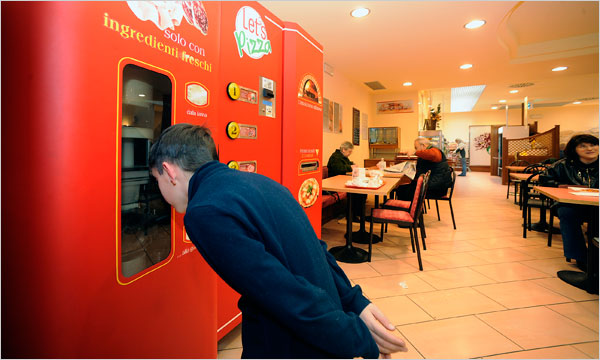
ROVERETO, Italy — Is Europe bringing back the automat? Claudio Torghele hopes so.
Over the last decade, Mr. Torghele, 56, an entrepreneur in this northern Italian city who first made money selling pasta in California, has developed a vending machine that cooks pizza. The machine does not just slip a frozen pizza into a microwave. It actually whips up flour, water, tomato sauce and fresh ingredients to produce a piping hot pizza in about three minutes.
The machine, which Mr. Torghele calls Let’s Pizza, is only the spearhead of a trend. Restaurants reminiscent of the old Horn & Hardart chain in the United States, which are fully automatic, are also showing up around the Continent.
Unlike the old automats (the last Horn & Hardart closed in 1991), which were staffed with workers who refilled the machines with creamed spinach and baked beans as fast as customers pulled them out, these restaurants consist entirely of vending machines.
In Milan, a two-hour drive west of Rovereto, a franchise chain called Brekky has opened the first three of what is planned to be a large chain of restaurants in which customers can buy cold dishes like salads and sandwiches, and warm dishes like pasta, from vending machines.
North of the Alps, the automat never really died out. In the Netherlands, Febo, a chain started in 1941 by a Dutch baker, now has about 60 restaurants. In France, bright green and yellow Yatoo Partoo machines — the name loosely translates as “You can get everything, everywhere” — sell milk, juice, snacks and sandwiches 24 hours a day, seven days a week.
The European vending machine industry, which has grown significantly and now has annual sales of about 26 billion euros, or $33 billion, hopes the trend will catch on.
Much recent growth came with the placing of vending machines in factories and offices, where employees took coffee breaks or lunch from machines. But as recession bit into Europe and factories and offices closed, that market has contracted.
At the same time, Europeans are looking for less expensive ways to eat out, and the automat is far less expensive than a white-tablecloth restaurant.
“These are developments that we are watching,” said Luciano Iannuzzi, chief executive of Argenta in Carpi, Italy, a large vending operator with about 120,000 machines.
The idea for a pizza robot came to Mr. Torghele after he worked in California in the mid-1990s creating a fresh pasta manufacturer. “At food courts I saw a trend toward vending machines,” he said at his office in this mountain town. “In fast food, I saw pizza everywhere.”
With backing from a Dutch investment fund, his own capital and money from friends, he set to work. A plan to simply miniaturize industrial technology for producing frozen pizza failed, but by 2003 Mr. Torghele had produced a machine ready to be tested in Chicago and shown at a trade fair in Orlando, Fla.
That same year, with the help of Unilever, the British-Dutch food giant, he test-marketed 20 machines in Germany. “We had a bicycle,” he said. “Now we had to pedal.”
The machine Mr. Torghele and his engineers produced is outfitted with little windows so the customer can watch the pizza being made. As in the Charlie Chaplin film “Modern Times” (in miniature and without Chaplin) wheels turn and gears grind. The customer presses a button to choose one of four varieties — margherita (plain cheese and tomato sauce), bacon, ham or fresh greens. A plastic container dumps flour into a drum resembling a tiny washing machine; a squirt of water follows, and the drum goes into a spin cycle, forming a blob of dough that is then pressed flat to form a 12-inch disk.
Tomato paste is squirted onto the dough and cheese is added before it is lifted into a small infrared oven. The baked pizza then slips onto a cardboard tray and out into the customer’s waiting hands. Mr. Torghele says the pizza will cost as little $4.50, depending on the variety.